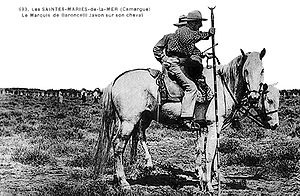Folco de Baroncelli-Javon
This article needs additional citations for verification. (November 2016) |
Folco de Baroncelli-Javon | |
|---|---|
 Baroncelli in full gardian attire | |
| Born | 1 November 1869 Aix-en-Provence |
| Died | 15 December 1943 (aged 74) Avignon |
| Occupation | writer, cattle breeder, cultural activist |
| Nationality | French |
| Period | early 20th century |
| Literary movement | Félibrige |
| Relatives | Jacques de Baroncelli (brother); Georges Dufrénoy (brother-in-law) |
Folco de Baroncelli-Javon (1 November 1869 – 15 December 1943), was a French writer and cattle farmer. As an influential gardian (a kind of Provençal cowboy), he is an important figure in the traditional lifestyle and culture of the Camargue region of southern France.
Family and childhood
Though born in
His brother was Jacques de Baroncelli, later a famous film director, and his sister, Marguerite de Baroncelli-Javon, later became 'queen' of the Occitan cultural movement known as the Félibrige, and married the post-impressionist painter Georges Dufrénoy.
Life in the Camargue
In 1895, lou Marquès ('the Marquis'), as he was then known, moved to the Camargue and raised a herd of cattle called the Manado Santenco (the 'Saintois herd') in Saintes-Maries-de-la-Mer. He married the daughter of a Châteauneuf-du-Pape landowner, and had three daughters, but his wife did not take to the climate of the Camargue and their life together was patchy. Nevertheless, he settled in Saintes-Maries-de-la-Mer and became a tenant of a mas, or traditional ranch, called the Mas de l'Amarée.
In 1905, when an American rodeo show visited Nîmes, he met Joe Hammam and then Buffalo Bill. Becoming friendly, he offered the services of his gardians, who took part in Buffalo Bill's cowboys-and-Indians displays.
In May 1908, he met
Most importantly, perhaps, he played an active role in maintaining and fostering a native Camarguais culture. He was involved in codifying the nascent ‘
In 1909 he founded the Nacioun Gardiano (‘gardian nation') to preserve the traditions of the Camargue.[1]
In 1931, out of money, Baroncelli had to leave the Mas de l’Amarée. Locals offered him a patch of land nearby where he constructed a replica of his old ranch, calling it the Mas du Simbèu ('sign, emblem'; also the name given to the chief bull of a herd). Among other things, he became an important supporter of the Romany people in this area, and counted many Romani among his close friends.
The late 1930s were marked by a series of illnesses, and the outbreak of the Second World War would prove too disruptive for him. His ranch was requisitioned by German troops in 1943, and the Marquis was evicted to Saintes-Maries. Sick and disoriented, he finally died at Avignon in December 1943.
Legacy
The image which many in France have of the
Further reading
References
- JSTOR 40092939.
External links
- Folco de Baroncelli
- Nacioun Gardiano Archived 16 February 2011 at the Wayback Machine
